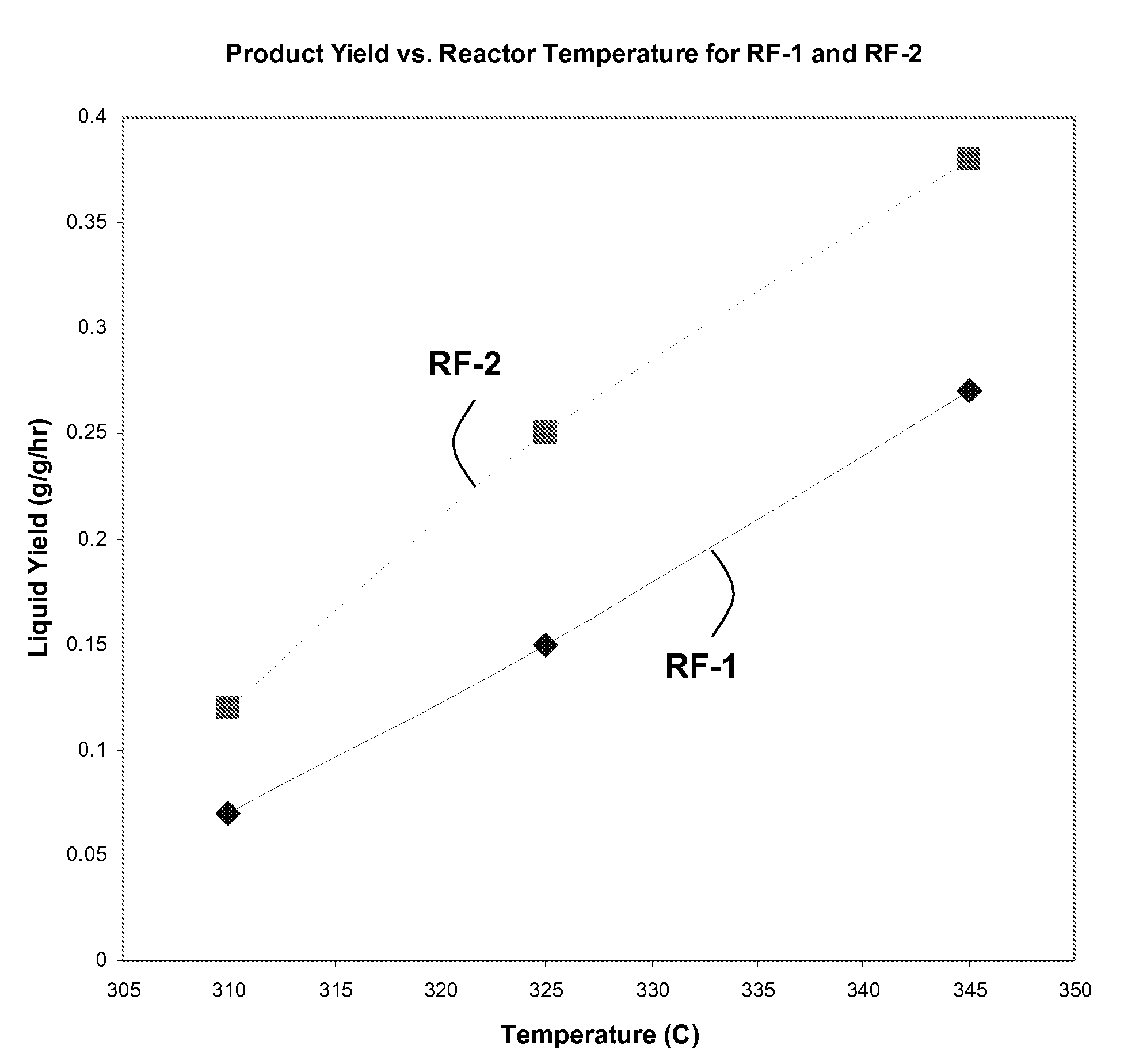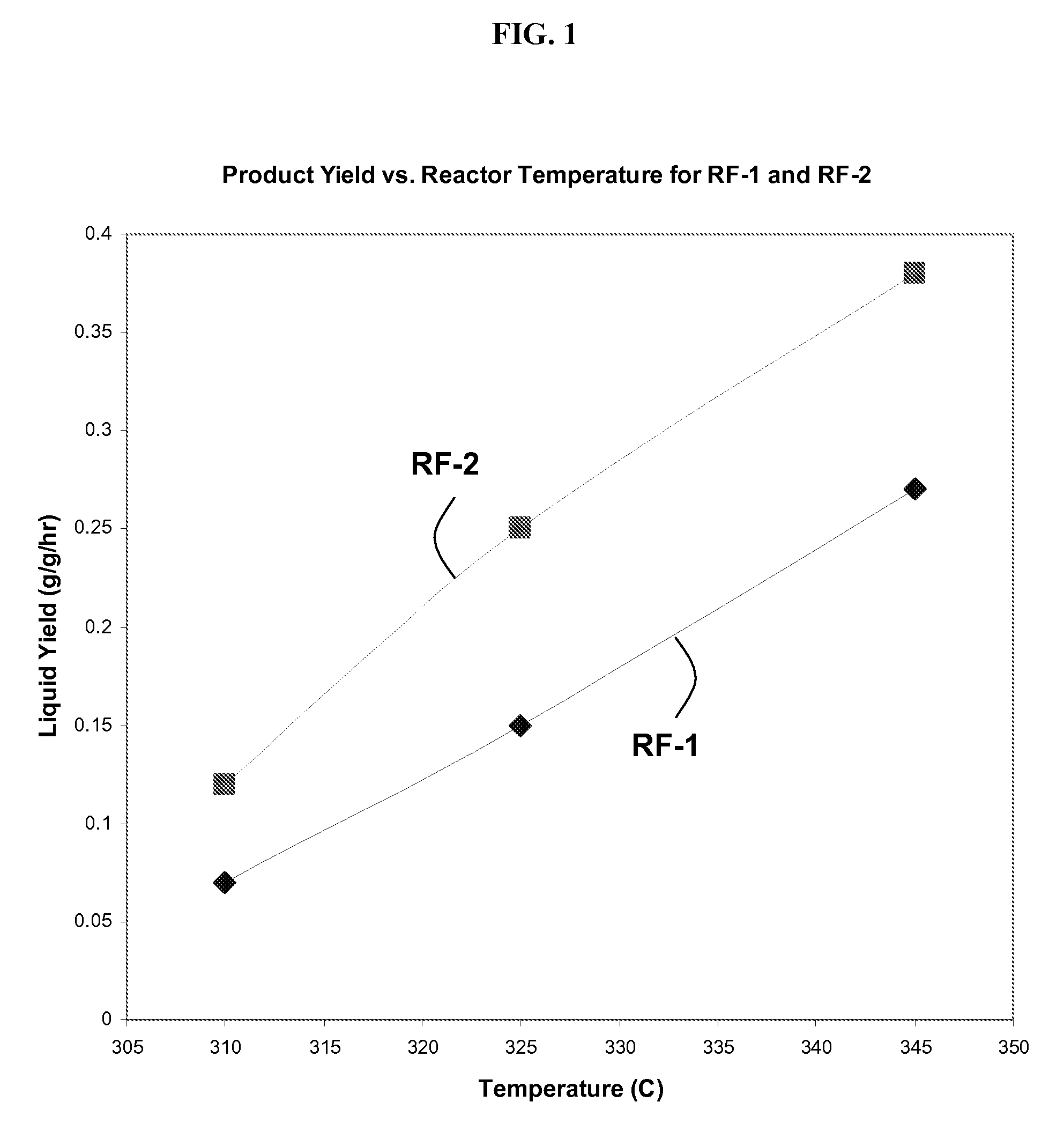Cobalt-molybdenum sulfide catalyst materials and methods for ethanol production from syngas
a technology of cobalt and molybdenum sulfide catalyst and catalyst materials, which is applied in the field of catalysts, can solve problems such as inability to realize advantages
- Summary
- Abstract
- Description
- Claims
- Application Information
AI Technical Summary
Benefits of technology
Problems solved by technology
Method used
Image
Examples
example 1
Performance of Compositions RF-1 and RF-2
[0109]Two catalyst compositions are produced and given the designations RF-1 and RF-2. Both compositions generally comprise Co—Mo—S and are produced in a similar manner, according to the description herein above, but the ultimate compositions that are obtained are different. The synthesis of RF-2 employs conditions that tend to exclude the atmosphere to a greater extent than the conditions for synthesis of RF-1.
[0110]In separate experiments, RF-1 and RF-2 catalysts are loaded into a reactor and tested for their capability to convert syngas into liquid products including ethanol. In these experiments, the primary variables are catalyst type (RF-1 or RF-2) and reactor temperature (310° C., 325° C., or 345° C.). A full-factorial experimental design is carried out, with 2×3=6 experiments. These experiments are each controlled to 30% CO conversion by adjusting space velocities.
[0111]FIG. 1 shows the impact of catalyst and temperature on total liqu...
example 2
Characterization of Compositions RF-1 and RF-2
[0112]The two catalyst compositions tested in actual reactors in Example 1, referred to as RF-1 and RF-2, are characterized in this example. The analysis for both compositions includes LECO S analysis, to determine total sulfur content; leaching the materials with chloroform, to assess the amount of elemental sulfur present; and leaching with 3N HCl, to assess the amount of hydrophilic, soluble sulfur, cobalt, and molybdenum. Three separate samples for each composition RF-1 and RF-2 are analyzed.
[0113]The mass fractions of total cobalt and total molybdenum are essentially the same for both RF-1 and RF-2, while the mass fractions of total sulfur are different (see tables below). The wt % numbers indicate the mean± standard deviation of the measurements. A t test value greater than 0.05 implies that there is no statistical basis to assert that differences exist, for that particular parameter, between RF-1 and RF-2.
[0114]
TotalCo (wt %)Total...
example 3
Experimental Co:S Molar Ratios for Certain Preferred Catalyst Compositions of the Invention
[0122]In this example, 18 distinct Co—Mo—S catalysts are synthesized in a manner experimentally similar to the procedure to synthesize RF-2 in Example 1. Due to imperfect process control, some variations in composition arise. A representative reactor experiment at 325° C. and 30% CO conversion (for reasons explained in Example 1) gives a liquid yield of about 0.21 g / g / hr and an ethanol yield of about 0.1 g ethanol per g catalyst per hour. With reference to the performance of RF-1 and RF-2, as shown in FIGS. 1 and 2, the performance of this single catalyst was measurably better than RF-1.
[0123]All 18 lots of catalyst in this example are analyzed by the same techniques as described in Example 2. It is of interest to consider the S:Co molar ratio, given an initial assignment of sulfur to molybdenum to yield MoS2.
[0124]FIG. 3 depicts the S:Co molar ratios across the 18 lots of catalysts synthesize...
PUM
| Property | Measurement | Unit |
|---|---|---|
| molar ratio | aaaaa | aaaaa |
| molar ratio | aaaaa | aaaaa |
| molar ratio | aaaaa | aaaaa |
Abstract
Description
Claims
Application Information
 Login to View More
Login to View More - R&D
- Intellectual Property
- Life Sciences
- Materials
- Tech Scout
- Unparalleled Data Quality
- Higher Quality Content
- 60% Fewer Hallucinations
Browse by: Latest US Patents, China's latest patents, Technical Efficacy Thesaurus, Application Domain, Technology Topic, Popular Technical Reports.
© 2025 PatSnap. All rights reserved.Legal|Privacy policy|Modern Slavery Act Transparency Statement|Sitemap|About US| Contact US: help@patsnap.com



